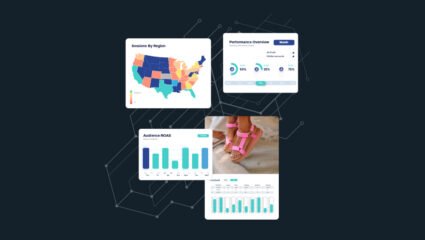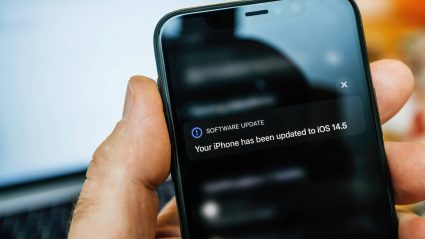It’s been two months since iOS 17 beta launched for developers and public testers. Now, the full public release is finally here–and there’s a lot to talk about. Unlike iOS 16, which launched to little fanfare back in September 2022, there’s already been much discussion among marketers about what Apple’s latest update means for marketing.
The biggest focus so far is Apple’s Link Tracking Protection (LTP), a feature designed with user privacy in mind that has some significant repercussions. As part of LTP, marketing query parameters that track user activity across various websites will be effectively removed. That means no more tracking on links shared in Messages, Mail, or Safari’s Private Browsing Mode.
iPhone users don’t always rush to update their OS (after all, who isn’t guilty of hitting “ignore” on their phone’s update pop-ups once or twice?), so it’ll take some time before the real impact of the update hits. LTP will also be exclusively available to users with newer device models, so some users might be left out of these new protections for longer. We expect approximately 90% of users will be using iOS 17 by the end of March 2024, based on past iOS launches.
But you need to start preparing now. So what can you expect from iOS 17, and how can your team adapt to succeed in this new era?
Changes to data collection could affect platform attribution and reporting
iOS 17 will pack the biggest punch for marketers relying on tracking parameters, like those in Google Ads and Meta Ads, and integrations with ad platforms.
LTP will eliminate tracking parameters, which could reduce the amount of data marketers can collect. Native or third-party integrations with ad platforms and their CRM systems will also lose their ability to identify users who click on ads, hindering their optimization of the offline sales funnel.
If you’re gathering information via form submissions, you might also experience a disruption in offline conversion tracking through forms. For example, if you currently pass marketing tracking parameters to a CRM platform, like Salesforce or Hubspot, those parameters will no longer be available in Private Browsing Mode on Safari.
This all sounds pretty bleak, but there is some good news: UTM parameters aren’t impacted and should still be available for aggregate engagement tracking (e.g. sessions) and aggregate conversion tracking (e.g. purchases) in analytics platforms like Google Analytics 4 (GA4).
While LTP might spell the end for certain tracking methods within ad platforms (i.e. without the FBCLID, you won’t be able to tie back user behavior to specific campaigns), you can still leverage UTMs and analytics tools to maintain valuable insights into your marketing efforts and campaign performances. You’ll just need to switch up your tracking methods to conform to LTP’s new restrictions.
Retargeting, personalization, and segmentation will get harder
More brands have embraced personalized experiences for customers, but iOS 17 will make personalization as we know it a much bigger challenge.
The removal of marketing parameters in URLs will make it difficult to provide personalized experiences or content tailored to a user’s past interactions.
Affected parameters include:
|
Query Parameter |
Vendor |
|
__hsfp |
HubSpot |
|
__hssc |
HubSpot |
|
_hsenc |
HubSpot |
|
__hstc |
HubSpot |
| __s |
Drip |
|
_openstat |
OpenStat |
|
dclid |
Google Display & Video 360 (DoubleClick Click Identifier) |
|
fbclid |
Meta Click Id – Meta in-app browser not impacted until user opens in Safari |
|
gclid |
Google Search Ads 360 (Google Click Identifier) – gbraid and wbraid parameters are not impacted |
|
hsCtaTracking |
HubSpot |
|
igshid |
|
|
mc_eid |
MailChimp |
|
mkt_tok |
Marketo (Adobe) |
|
ml_subscriber |
MailerLite |
| ml_subscriber_hash |
MailerLite |
|
msclkid |
Microsoft Ads Click Id |
| oly_anon_id |
Omeda Olytics |
|
oly_enc_id |
Omeda Olytics |
|
rb_clickid |
VK Ads |
|
s_cid |
Adobe Site Catalyst Campaign Tracking |
| twclid |
Twitter Click Id |
|
vero_conv |
Vero Campaign Tracking |
|
vero_id |
Vero Campaign Tracking |
| wickedid |
Wicked Reports |
| yclid |
Yandex |
Source: https://privacytests.org/
The new restrictions mean detailed user data for personalized targeting and segmentation purposes will be limited. You’ll no longer be able to target users who visited your site, and you may have trouble constructing specific user segments based on click-through behavior.
If, for example, you’re looking to tailor an experience for Meta users who engaged with a particular ad and explored product category pages on your website, you’re out of luck. You can’t target people who click on your ad and visit your site. But you can still do some targeting by tracking category pages if you have the Meta pixel installed on your site.
These kinds of limitations and workarounds will define personalization in the post-iOS 17 world. Personalization will be harder, but not impossible if your team can think creatively about ways to gather information about users.
Across the board, collecting first-party data directly from your audience will be key to great personalized experiences. You’ll also need to lean into great creative that speaks directly to your audience even as targeting gets more broad.
Preparing for the new iOS 17 features
New data privacy restrictions always put a wrench in marketing plans, but don’t panic. There’s a lot you can do to prep your strategy for iOS 17.
You should start by assessing the scale of the update’s potential impact on your business and determining exactly what will be affected (and how).
Review your analytics platform (GA4, Adobe Analytics, etc.) and ad platform data to identify the traffic and conversions generated by iOS and Safari browsers. This is the traffic that you’ll be losing track of with the new update, so if few of your users come from there, you’ll be less impacted by the new OS.
Since UTMs are not impacted by the iOS 17 release, make sure your UTMs are properly implemented across all paid channels so you can retain access to more insights.
Finally, go through this checklist from our experts to ensure a seamless transition to iOS 17:
- Double-check non-platform tracking
- Make sure your UTMs are defined consistently, whether added automatically by your ad platform or manually message-by-message
- Use GA4 to set up custom events, as relevant, that can be tracked against those campaign or message-level UTMs
- Monitor your data to identify and assess any new changes
- Monitor your platform’s reporting closely during Q4 2023 and Q1 2024. Do clicks look different month-over-month and year-over-year, isolated from other program changes?
- Monitor how trendlines are changing between clicks reported on-platform and sessions reported in GA4
- Adjust segmentation strategies
- Use multiple parameters for defining “active” contacts
- Adjust automation strategies
- Audit your program for specific click-driven triggers and filters
- Embrace privacy-safe technologies
- Collect more zero-party data for retargeting over owned channels like email and SMS
- Use Consent Management Platforms (like OneTrust, Cookiebot, etc.) to ensure you’re respecting user preferences about how their data is shared
- Leverage server-side tracking or enhanced conversions (like Meta CAPI) to pass first-party data back to ad platforms once you have consent or use solutions like Google Ads Enhanced Conversions to securely hash personally identifiable information (PII) to build audiences
- Lean into cookieless testing and forecasting solutions
- Use incrementality testing to determine whether advertising campaigns are truly driving additional sales or revenue
Like any change, iOS 17 might be scary at first, but this update is just one more wave in the tide of data deprecation. Your team should already be working toward a marketing strategy based on first-party data and excellent creative. If you’re not, consider this a final warning and get started now.
Ready to take control of your data destiny? Download our full comprehensive guide to creating a first-class, futureproof measurement strategy.









Responses